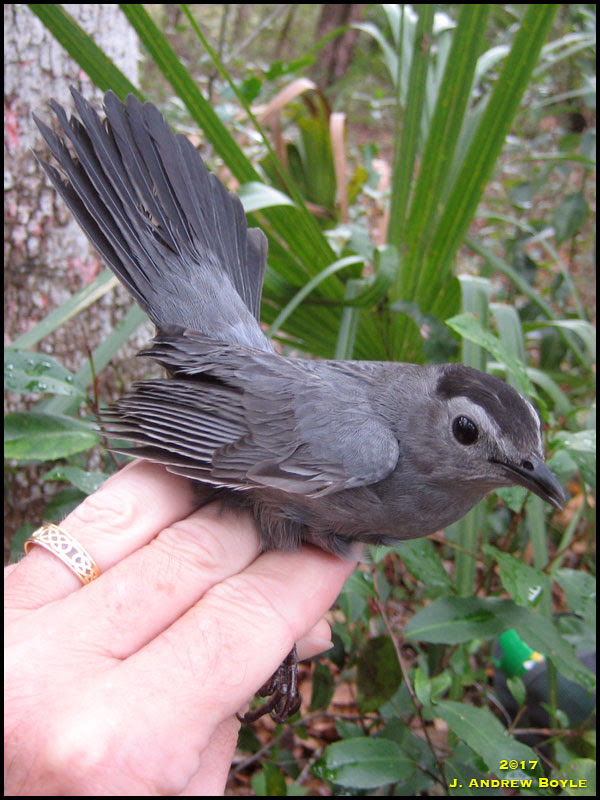Our post title has a double meaning this week. Winter is winding down and you can feel it is the air and see it all around. The only trouble this Sunday was dodging a few sprinkles as the trailing edge of a front moved through overnight. Luckily, there were only a couple of brief periods of light rain and the wind did not show up until near 10 AM.
Though Northern Cardinals were the most heard calls early on, we did not capture any of them. Instead we started with a juvenile Carolina Wren we first banded last year after being born on site..

As we watched a large feeding flock of Kinglets, Blue-gray Gnatcatchers, and newly arriving Northern Parula overhead, a female Common Yellowthroat flew into Net 19 next to us. This was another recapture that we first banded last October on her journey South. Now birds are beginning to move back North as witnessed by Robins flying over in larger numbers and by examining NEXRAD radar.

It was starting to look like we were only going to get recaptured birds today as we got a Wintering Hermit Thrush (now caught for the third time) and another Carolina Wren banded a couple of years earlier.

We watched as one of the Barred Owls entered the nest tree across the river at one point. A little later, we noticed a wing sticking out of the nest. The owl was twitching at times suggesting that it was either feeding a newly hatched chick or rolling an egg for incubation.

Yet another sign that Spring is rushing toward us is all of the newly blooming plants and trees. Native Black Cherry and Cherry Laurel, Earthsmoke, Wild Radish, and Spider Wort,
(Tradescantia), are coloring the landscape.

Richard discovered that our Bobcat has established a new bathroom spot. The scat was next to Net 2 behind the banding table.

Our next bird was a female Ruby-crowned Kinglet. This species is feeding furiously all over the property right now.

Hanging in Net 22 was our single House Wren of the day.

A little farther down the lane at Net 18 was our first Myrtle Warbler (Yellow-rumped Warbler) of the season. Their numbers are increasing in Central Florida. Finally. The second 'turning' referenced in the post title is the fact that the warblers are phasing into their breeding plumage like this male bird.

While those birds were being extracted, Richard got a Swamp Sparrow, also nearing full breeding plumage colors, in Net 11.

Nearby, Phyllis found a recaptured Gray Catbird in Net 20.

Since we caught our first Myrtle Warbler earlier in the day and the fact that we were watching a large feeding flock at the edge of the marsh, we kept the nets open a little longer while we banded the previous birds. Christine got another Myrtle Warbler in Net 18 and walked over to the spot where Andrew was watching the flock from the woods. Many birds were feeding low and heading in the same direction of the net. A couple of minutes later we had an additional six birds in the net from one end to the other.

The majority of the Myrtles were adult males.

A pair of more drab females were also in the mix.

The plumage on this older male is the closest to full breeding colors we see in Florida before they head up toward Canada to nest. Gorgeous warblers.

A very nice mix of birds today. Our capture rates should begin to rise as we head toward March when Spring migration goes into full swing. Glad we are getting the Myrtles and it is always a joy to be hearing Northern Parulas singing up and down the river.
______________________________________
Next (planned) Banding Day: Sunday, February 26th.
All nets will be opened by 6:25 A.M.